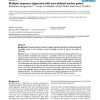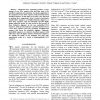799 search results - page 59 / 160 » Function Sequence Genetic Programming |
BMCBI
2010
13 years 9 months ago
2010
Background: While most multiple sequence alignment programs expect that all or most of their input is known to be homologous, and penalise insertions and deletions, this is not a ...
ALMOB
2006
13 years 9 months ago
2006
Background: Automated software tools for multiple alignment often fail to produce biologically meaningful results. In such situations, expert knowledge can help to improve the qua...
BMCBI
2010
13 years 9 months ago
2010
Background: The pan-genome of a bacterial species consists of a core and an accessory gene pool. The accessory genome is thought to be an important source of genetic variability i...
CSIE
2009
IEEE
14 years 3 months ago
2009
IEEE
— Automated DNA sequencing produces a large amount of raw DNA sequence data that then needs to be classified, organized, and annotation. One major application is the comparison o...
ENTCS
2002
13 years 8 months ago
2002
The difficulty of finding errors caused by unexpected interleavings of threads in concurrent programs is well known. Model checkers can pinpoint such errors and verify correctness...


